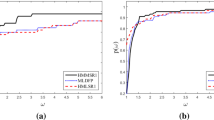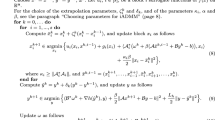Abstract
The matrix model updating problem (MUP), considered in this paper, concerns updating a symmetric second-order finite element model so that the updated model reproduces a set of measured or given eigenvalues and eigenvectors, and preserves the symmetry, positive semidefiniteness and sparsity of the original model simultaneously. By exploiting the special structure offered by the constraint set, the optimization problem for MUP is formulated in such a way that the proximal point-like method can be used to solve the equivalent problem. We show that the proposed method converges globally and numerical results show that the proposed method works well for incomplete measured data.








Similar content being viewed by others
References
Al-Ammari M, Tisseur F (2012) Standard triples of structured matrix polynomials. Linear Algebra Appl 437(3):817–834
Bai Z-J, Chu D, Sun D (2007) A dual optimization approach to inverse quadratic eigenvalue problems with partial eigenstructure. SIAM J Sci Comput 29:2531–2561
Bai Z-J (2008) Symmetric tridiagonal inverse quadratic eigenvalue problems with partial eigendata. Inverse Probl 24:015005
Bai Z-J, Ching W-K (2009) A smoothing Newton’s method for the construction of a damped vibrating system from noisy test eigendata. Numer Linear Algebra Appl 16:109–128
Bai Z-J, Chen M-X, Yuan X-M (2013) Applications of the alternating direction method of multipliers to the semidefinite inverse quadratic eigenvalue problem with partial eigenstructure. Inverse Probl 29:075011
Baruch M (1978) Optimization procedure to correct stiffness and flexibility matrices using vibration data. AIAA J 16:1208–1210
Benner P, Laub AJ, Mehrmann V (1995) A collection of benchmark examples for the numerical solutions of algebraic Riccati equations I: continuous-time case. http://www.tu-chemnitz.de/pester/sfb/spc95pr.html
Blum E, Oettli W (1975) Mathematische Optimierung., Econometrics and operations researchSpringer, Berlin
Carvalho J, Datta B, Lin W-W, Wang C-S (2006) Symmetry preserving eigenvalue embedding in finite-element model updating of vibrating structures. J Sound Vib 290:839–864
Chu D, Chu M-T, Lin W-W (2009) Quadratic model updating with symmetric, positive definiteness, and no spill-over. SIAM J Matrix Anal Appl 31:546–564
Datta BN (2003) Numerical methods for linear control systems. Elsevier, California
Datta BN, Sokolov V (2011) A solution of the affine quadratic inverse eigenvalue problem. Linear Algebra Appl 434:1745–1760
Friswell M, Mottershead J (1995) Finite element model updating in structural dynamics., Solid mechanics and its applicationsKluwer, Dordrecht
Friswell M, Inman D, Pikey D (1998) The direct updating of damping and stiffness matrices. AIAA J 36:491–493
Golub GH, Van Loan CF (1996) Matrix Comput, 3rd edn. Johns Hopkins University Press, Baltimore and London
He B-S, Yuan X-M (2010) A contraction method with implementable proximal regularization for linearly constrained convex programming. Optimization Online. http://www.optimization-online.org/DB_HTML/2010/11/2817.html
He B-S, Yuan X-M, Zhang W-X (2013) A customized proximal point algorithm for convex minimization with linear constraints. Comput Optim Appl 56(2013):559–572
He B-S, Fu X-L, Jiang Z-K (2009) Proximal-point algorithm using a linear proximal term. J Optim Theory Appl 141:299–319
He B-S, Shen Y (2012) On the convergence rate of customized proximal point algorithm for convex optimization and saddle-point problem. Sic Sin Math 42:515–525 (in Chinese)
Higham NJ (1988) Computing a nearest symmetric positive semidefinite matrix. Linear Algebra Appl 103:103–118
Jia Z-G, Wei M-S (2011) A real-valued spectral decomposition of the undamped gyroscopic system with applications. SIAM J Matrix Anal Appl 32(2):584–604
Kabe AM (1985) Stiffness matrix adjustment using mode data. AIAA J 23:1431–1436
Kuo Y-C, Lin W-W, Xu S-F (2006) New methods for finite element model updating problems. AIAA J 44:1310–1316
Lancaster P (2008) Model-updating for self-adjoint quadratic eigenvalue problems. Linear Algebra Appl 428:2778–2790
Lancaster P (2013) Stability of linear gyroscopic systems: a review. Linear Algebra Appl 439(3):686–706
Martinet B (1970) Regularisation, d’in\(\acute{e}\)quations variationelles par approximations succesives. Rev Francaise d’Inform Recherche Oper 4:154–159
Nocedal J, Wright SJ (1999) Numer Optim. Springer, Berlin
Rochkafellar RT (1976) Monotone operators and the proximal point algorithm. SIAM J Control Optim 14:877–898
Tisseur F, Meerbergen K (2001) The quadratic eigenvalue problem. SIAM Rev 43(2):235–286
Wei F (1990) Mass and stiffness interaction effects in analytical model modification. AIAA J 28:1686–1688
Xiao X-T, Gu J, Zhang L-W (2012) Quadratic model updating with gyroscopic structure from partial eigendata. Optim Eng 14:431–455
Xie D-X (2011) A numerical method of structure-preserving model updating problem and its perturbation theory. Appl Math Comput 217:6364–6371
Acknowledgments
We are grateful to the referees for useful comments and suggestions. This research was supported by the National Natural Science Foundation of China under Grant Nos. 11271117, 11371073 and 11371072.
Author information
Authors and Affiliations
Corresponding author
Additional information
Communicated by Ruben Spies.
Supported by the National Natural Science Foundation of China under Grant Nos. 11271117, 11371073 and 11371072.
Rights and permissions
About this article
Cite this article
Zhao, K., Liao, A. & Yao, G. A proximal point-like method for symmetric finite element model updating problems. Comp. Appl. Math. 34, 1251–1268 (2015). https://doi.org/10.1007/s40314-014-0176-1
Received:
Revised:
Accepted:
Published:
Issue Date:
DOI: https://doi.org/10.1007/s40314-014-0176-1
Keywords
- Model updating
- Proximal point method
- Quadratic eigenvalue problem
- Partially prescribed eigenvalue problem




